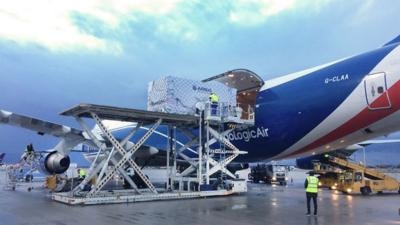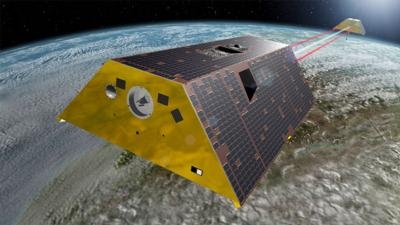Sat, Dec 16, 2017
German-Built Gravity Research Spacecraft Are On The Way To Vandenberg Air Force Base In California
The twin GRACE-FO satellites have begun their journey to Vandenberg Air Force Base in California. Together with test equipment totalling around 50 tons, the gravity research satellites built and developed by Airbus in Friedrichshafen (Germany) were loaded overnight onto an air freighter at Munich airport and flown to the U.S. Tuesday. GRACE-FO is a joint project between NASA’s Jet Propulsion Laboratory (JPL) based in Pasadena, California, and the German Research Center for Geosciences (GFZ) in Potsdam.

Both GRACE-FO research satellites are scheduled for launch in spring 2018, and will be placed in a polar orbit of around 310 miles and with a distance of 136 miles between them. The mission is planned to last at least five years. The satellites will constantly measure the distance between each other to within a few microns using a microwave system built at JPL. At the same time, a sensitive accelerometer, built at Onera in France, will account for non-gravitational effects, such as atmospheric drag and solar radiation.

The data will be used to track the movement of liquid water, ice and land masses by creating monthly maps of the changes in Earth’s gravitational field. GRACE-FO continues this essential climate record established by the predecessor GRACE mission, a joint project between the United States and Germany. GRACE ended its science operations in October after more than 15 years of operations.
The GRACE-FO satellites will also feature a new inter-satellite laser ranging instrument, developed in a German/American joint venture, which will be tested for use in future generations of satellites. In addition, each satellite will record up to 200 profiles per day of temperature distribution and water-vapour content in the atmosphere and the ionosphere to aid weather forecasting.
A team of 15 Airbus space engineers and technicians are currently awaiting the arrival of the satellites in California. The plan is to assemble all test systems on site and check the GRACE-FO spacecraft before the Christmas break in readiness for the launch campaign in 2018.
(Images provided with Airbus news release)
More News
Pilot Applied Full Aft Stick And Nose-Up Trim, But The Airplane Remained On The Runway Analysis: The pilot reported that a preflight inspection and flight control checks revealed n>[...]
A Few Questions AND Answers To Help You Get MORE Out of ANN! 1) I forgot my password. How do I find it? 1) Easy... click here and give us your e-mail address--we'll send it to you >[...]
From 2022 (YouTube Edition): Before They’re All Gone... Humankind has been messing about in airplanes for almost 120-years. In that time, thousands of aircraft representing i>[...]
Advanced Air Mobility (AAM) A transportation system that transports people and property by air between two points in the NAS using aircraft with advanced technologies, including el>[...]
Aero Linx: MQ-1B Predator The MQ-1B Predator is an armed, multi-mission, medium-altitude, long-endurance remotely piloted aircraft that is employed primarily as an intelligence-col>[...]
 NTSB Final Report: Douglas A-4K
NTSB Final Report: Douglas A-4K ANN FAQ: Q&A 101
ANN FAQ: Q&A 101 Classic Aero-TV: PBY Catalina--From Wartime to Double Sunrise to the Long Sunset
Classic Aero-TV: PBY Catalina--From Wartime to Double Sunrise to the Long Sunset ANN's Daily Aero-Term (07.01.25): Advanced Air Mobility (AAM)
ANN's Daily Aero-Term (07.01.25): Advanced Air Mobility (AAM) ANN's Daily Aero-Linx (07.01.25)
ANN's Daily Aero-Linx (07.01.25)




